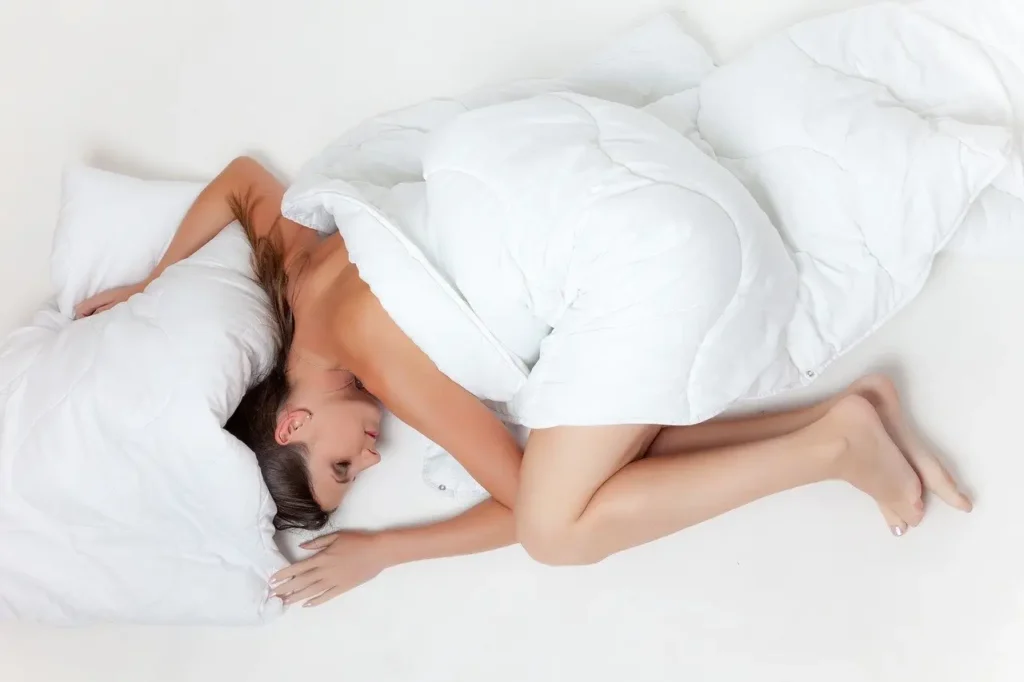Sleep, a necessity as vital as the air we breathe, has evolved dramatically from our ancestors’ times to the present day. Our predecessors ventured through various phases, from dual sleeping shifts known as first and second sleep to communal bed-sharing, reflecting practices deeply rooted in history. Today, however, the focus has shifted towards finding the best sleep position that enhances sleep quality and addresses common ailments like insomnia, sleep apnea, and acid reflux, among others. The quest for the ideal sleep posture intersects with the science of sleep, acknowledging the profound impact of sleep on our health and cognitive function.
As we delve into this journey from ancient times to modern beds, it’s crucial to understand how technological advancements, societal changes, and medical insights have influenced the best sleep positions for conditions including restless legs syndrome, back and shoulder pain, and even the best sleep position during pregnancy. This article is committed to guiding you through these evolutions with expertise, authority, and trust, highlighting the significance of choosing the right sleep posture for a holistic lifestyle. Join us on our YouTube Channel for more tips on embracing a wholesome approach to sleep and beyond, enhancing your well-being and optimizing your sleep quality.
The Impact of Sleep Position on Health and Sleep Quality
Right-Side Lying and Sleep Quality
Research indicates that individuals who prefer lying on their right side tend to have better sleep quality, with a lower frequency of turning throughout the night. This position not only aids in recovery after sleep but also extends the duration of slow-wave sleep, which is crucial for cognitive function and memory consolidation.
Challenges with Stomach and Back Sleeping
Stomach sleeping, while popular, can lead to significant strain on the neck and lower back, potentially causing long-term alignment issues. Similarly, back sleeping might exacerbate conditions like snoring, sleep apnea, and can lead to lower back pain, making it a less ideal position for many, including pregnant women and older adults.
Benefits of Side Sleeping
Side sleeping emerges as a beneficial posture for a variety of conditions. It is especially recommended for pregnant women, individuals suffering from acid reflux, back pain, snoring, and sleep apnea. Incorporating a pillow between the legs or under the knees can further alleviate pressure and enhance comfort, promoting better spinal alignment and sleep quality.
The Influence of Sleep Position on Specific Conditions
The fetal position, preferred by over 40% of people, supports the spine’s natural alignment and may enhance brain waste clearance, potentially reducing the risk of neurodegenerative diseases like Alzheimer’s. Conversely, the soldier and starfish positions, while helping some conditions like acid reflux, can increase the risk of snoring and sleep apnea due to the mechanics of airway obstruction.
Adjusting Sleep Positions
Adapting to a new sleep position can be a gradual process that benefits from the support of tailored bedding solutions such as supportive mattresses and contour pillows, particularly for side sleepers. This adjustment is crucial as it can significantly impact overall sleep quality and health.
Historical and Modern Perspectives on Sleep Surfaces
Traditionally, sleeping on the ground or firm surfaces was common and is still recommended by some modern experts to support spinal alignment and reduce back pain. This highlights the evolving understanding of the interplay between sleep surface firmness, sleep posture, and health outcomes.
Ancient Sleeping Techniques and Their Relevance Today
Revisiting Ancient Sleeping Techniques
- Segmented Sleep: A Timeless Practice
The concept of segmented sleep, which involves two sleep periods of about four hours each, separated by a wakeful interlude, was a common practice in preindustrial times. During this wakeful period, individuals engaged in activities like reading, writing, or meditating, which are thought to contribute to a more restorative sleep. - Biphasic Sleep: Enhancing Cognitive Functions
Another ancient technique, biphasic sleep, divides sleep into a main nocturnal block and a shorter daytime nap. This pattern has been shown to improve memory, alertness, and cognitive function, making it a valuable consideration for modern lifestyles. - Meditation and Relaxation: Ancient Tools for Modern Sleep
Techniques such as deep breathing and progressive muscle relaxation have been used for millennia to promote better sleep. These practices not only continue to be relevant but are integral to contemporary sleep therapy to combat stress and insomnia. - Cultural Legacy of Sleep Practices
Ancient civilizations often viewed sleep as a sacred period necessary for healing and spiritual connection. This reverence for sleep has shaped various cultural attitudes toward rest, influencing both ancient and modern sleep practices. - Adapting Ancient Methods for Today’s Sleep Challenges
The relevance of ancient sleep techniques in today’s world is increasingly recognized, especially as they offer solutions to modern problems like sleep deprivation and disrupted circadian rhythms. Techniques such as the two-sleep cycle have been found to improve not only memory but also productivity.
By understanding and integrating these ancient practices, we can enhance our approach to sleep, combining the wisdom of the past with today’s scientific advancements. Join our YouTube Channel for more insights into how you can incorporate these timeless techniques into your modern sleep routine, ensuring a holistic approach to rest and rejuvenation.
The Science Behind Sleep Positions
Understanding the Psychological and Physical Implications of Sleep Positions
Research suggests that the position in which you sleep can reveal aspects of your personality and significantly affect your physical health. For instance, over 60% of adults predominantly sleep on their side, a position linked with numerous health benefits. Here’s how different sleep positions may impact you:
- Fetal Position: Often chosen by individuals who are described as anxious or emotional, this position might reflect a protective, comfort-seeking trait.
- Log Position: Those who sleep like a log, with arms by their sides, are typically sociable and easygoing, though they might be more trusting than is ideal.
- Yearner Position: Sleeping with arms outstretched, as if reaching for something, suggests openness yet a hint of cynicism and suspicion.
- Soldier Position: Lying on the back with arms straight along the body indicates a quiet and reserved personality, often with high standards for themselves and others.
- Starfish Position: Starfish sleepers, who lie on their backs with arms up around their pillow, are good listeners and naturally helpful.
- Freefall Position: Those who sleep on their stomachs with their hands around the pillow and heads turned to the side tend to be social but sensitive to criticism.
Additionally, the frequency of turning throughout the night varies greatly among individuals, complicating the ability to predict sleep patterns through mathematical models. Understanding these nuances offers a fascinating glimpse into the complex interplay between our sleep habits and our personalities.
The Role of Sleep Position in Enhancing Relationship and Emotional Health
Sleeping positions not only reflect individual traits but also affect interpersonal relationships. For instance, spooning with a partner can release oxytocin, known as the ‘love hormone,’ which helps to reduce stress and deepen bonds between partners. This hormone plays a crucial role in creating a sense of closeness and security, making spooning a beneficial position for both emotional and physical health.
Evolutionary Perspectives on Sleep Position
The evolution of sleep positions reveals adaptations to environmental threats and social structures. The REM (rapid eye movement) phase of sleep, associated with vivid dreaming, has become more prominent in humans. This phase likely evolved as a response to predation threats when early humans began sleeping on the ground. The formation of a social shell, where groups shared simple shelters, provided safety and warmth, allowing for more vulnerable sleep positions.
By exploring these diverse aspects, we gain insights into how our sleeping positions are more than just a matter of comfort—they are a window into our psyche and a reflection of millennia of evolutionary adaptation. Join our YouTube Channel for more expert insights and tips on optimizing your sleep for a holistic lifestyle.
Technology and Modern Bedding: Enhancing or Hindering Sleep?
The Dual Impact of Modern Bedding and Technology on Sleep
The Role of Modern Bedding
Modern mattresses are designed to strike a balance between firmness and softness, supporting the back and accommodating various sleep positions. This advancement in bedding technology aims to enhance sleep quality by adapting to the body’s contours, providing both support and comfort throughout the night.
Technology in the Bedroom
The presence of electronic devices in bedrooms is widespread, with approximately 75% of children and 70% of adults engaging with technology in their sleep environments. Despite the convenience of having technology at arm’s reach, its impact on sleep is predominantly negative. Devices emit blue light that disrupts melatonin production, which is essential for regulating sleep cycles. The noise and lights from notifications can also lead to frequent awakenings.
Recommendations for Reducing Technological Disruptions
Experts strongly advise against the use of electronic devices close to bedtime. Strategies for an electronic-free bedtime routine include:
- Turning off notifications to prevent disturbances.
- Establishing a “No Screen” rule at least 30 to 60 minutes before sleep, especially for children and teenagers.
- Creating a calming pre-bedtime routine that does not involve screens, such as reading or meditation.
- Keeping the bedroom environment conducive to sleep by ensuring it is cool, dark, quiet, and free from clutter.
Technological Tools for Better Sleep
While technology can hinder sleep, certain innovations like light therapy devices and sleep-tracking technology can be beneficial. These tools are designed to help regulate circadian rhythms and improve overall sleep patterns, offering a modern solution to age-old sleep challenges.
Join our YouTube Channel for more expert insights and tips on optimizing your sleep for a holistic lifestyle, where we explore both the challenges and solutions technology brings to our sleep environments.
Practical Tips for Improving Sleep Posture and Quality
Understanding and Implementing Good Sleep Posture
- Maintain the Natural Spinal Curve
Ensuring your spine maintains its natural S-shape during sleep is crucial. This involves aligning your neck, hips, and knees to avoid straining your back and neck muscles. - Select the Right Mattress and Pillow
Opt for a medium-firm mattress that supports the spine correctly and prevents unnatural bending. Complement this with a supportive pillow that keeps your head and neck in a neutral alignment. - Avoid Stomach Sleeping
Stomach sleeping can increase the risk of neck and back pain due to poor alignment. If you find yourself in this position, try transitioning to side or back sleeping to enhance your comfort and sleep quality. - Pillow Placement for Side and Back Sleepers
If you’re a side sleeper, placing a pillow between your knees can help maintain pelvic and spinal alignment. For back sleepers, a pillow under the knees can support the natural curve of your lower back. - Create a Conducive Sleep Environment
Minimize noise and light disturbances, maintain a cool room temperature, and establish a consistent sleep schedule. Also, limit screen time before bed to enhance your sleep quality and posture. - Consult Healthcare Providers
Consulting a healthcare provider can provide tailored advice and solutions if you have persistent sleep posture issues or experience discomfort during sleep.
By understanding and applying these practical tips, you can significantly improve your sleep posture and overall sleep quality. For more expert insights and guidance on embracing a holistic lifestyle, join our YouTube Channel and discover how to optimize your sleep and well-being.
Conclusion
Tracing the evolution of sleep from ancestral times to the modern day, we’ve explored how changes in lifestyle, advancements in science, and an increased understanding of health have informed our choices in sleep positions and environments for enhanced well-being. By revisiting ancient practices and integrating them with contemporary scientific insights, we underscore the importance of choosing the right sleep posture to not only improve sleep quality but also to address various health conditions effectively. Our journey emphasizes the expertise and authority embedded in the science of sleep, advocating for a [trustworthy approach to holistic living].
As we continue to navigate the complexities of sleep in our modern world, it’s clear that the pursuit of optimal sleep health is more relevant than ever. The implications of our chosen sleep positions on physical and mental health highlight the significance of informed decision-making in our daily routines. In aligning with practices that promote a holistic approach to wellness, we invite you to join our journey towards better sleep and overall health. To delve deeper into how you can optimize your lifestyle beyond superior sleep quality, [join our YouTube Channel] for more tips and insights. You can also check our post on “Natural Ways to Battle Chronic Fatigue Syndrome -CFS: A Holistic Review“.
DISCLAIMER:
The information provided in this article is for educational purposes only and should not be considered medical advice. Always consult with a qualified healthcare professional before making any changes to your health regimen or treatment plan.
FAQs
What sleeping posture is believed to be the original one for humans? Early humans are thought to have slept in the fetal position due to the small and round nature of their rudimentary ‘beds’. They would follow the natural light cycle, sleeping after dark and waking with the sunrise. If they needed to wake up earlier than usual, they would drink a lot of water before bed to ensure they would wake up early to relieve themselves.
How have sleeping habits changed throughout history? Sleep patterns have undergone significant changes over time. In pre-industrial societies, people often had segmented sleep, alternating between periods of rest and activity during the night. The introduction of artificial lighting and the lifestyle changes brought on by modern urban living have led to a transformation in how we sleep.
In what ways have beds evolved since ancient times? Since the 5th century, mattresses have remained relatively unchanged. However, bed frames have seen more elaborate designs, especially after the medieval period, with intricate wood carvings becoming common. During the Saxon era, mattresses were typically made of rough straw and covered with decorative fabric, whereas the Normans introduced iron railings to drape curtains around the bed.
What were the precursors to contemporary beds like? Before the advent of modern beds, early Americans used wooden bedsteads with either rope or leather sacking; They topped it with corn husk or horsehair mattresses. Additionally, they used featherbeds, bolsters, and pillows for comfort. Notably, Betsy Ross was known for making beds as well as flags. Some Native American groups also utilized wooden bedsteads in their sleeping arrangements.





